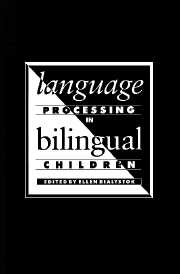Book contents
- Frontmatter
- Contents
- List of figures
- List of tables
- List of contributors
- Preface
- Introduction
- 1 Language modules and bilingual processing
- 2 Phonological processing in two languages
- 3 Second-language learning in children: a model of language learning in social context
- 4 Interdependence of first- and second-language proficiency in bilingual children
- 5 Giving formal definitions: a linguistic or metalinguistic skill?
- 6 Metalinguistic dimensions of bilingual language proficiency
- 7 Translation skill and metalinguistic awareness in bilinguals
- 8 Towards an explanatory model of the interaction between bilingualism and cognitive development
- 9 Constructive processes in bilingualism and their cognitive growth effects
- 10 Language, cognition, and education of bilingual children
- Index
8 - Towards an explanatory model of the interaction between bilingualism and cognitive development
Published online by Cambridge University Press: 11 January 2010
- Frontmatter
- Contents
- List of figures
- List of tables
- List of contributors
- Preface
- Introduction
- 1 Language modules and bilingual processing
- 2 Phonological processing in two languages
- 3 Second-language learning in children: a model of language learning in social context
- 4 Interdependence of first- and second-language proficiency in bilingual children
- 5 Giving formal definitions: a linguistic or metalinguistic skill?
- 6 Metalinguistic dimensions of bilingual language proficiency
- 7 Translation skill and metalinguistic awareness in bilinguals
- 8 Towards an explanatory model of the interaction between bilingualism and cognitive development
- 9 Constructive processes in bilingualism and their cognitive growth effects
- 10 Language, cognition, and education of bilingual children
- Index
Summary
During the past twenty years research has shown, with some degree of consistency, that learning a second language in childhood, either by simultaneous acquisition or in the context of bilingual education, is associated with positive cognitive gains. In both bilingual—monolingual comparisons and in studies using “within-bilingual” designs, children's bilingualism is positively related to concept formation, classification, creativity, analogical reasoning, and visual-spatial skills, to name a few (Diaz, 1983; Hakuta, Ferdman, & Diaz, 1987). In addition, as is evident in several chapters of the present volume, bilingual children have demonstrated a particularly refined awareness and control of the objective properties of language, commonly referred to as metalinguistic skills. Ben-Zeev (1977), for example, found that bilingual children approached linguistic tasks with a special sensitivity to language structure and detail. More recently, Bialystok (1986) has shown that children's bilingualism positively affects their increasing ability to solve problems involving high levels of control of linguistic processing.
Even though we have substantial documentation of the cognitive and metalinguistic advantages of childhood bilingualism, an important issue remains unresolved; namely, researchers have not yet developed and tested the validity of an explanatory model of how or why bilingualism has such positive effects. To date, it is not clear, for example, how bilinguals' metalinguistic skills are related to advantages in cognitive abilities not directly related to language, such as classification or visual spatial skills.
- Type
- Chapter
- Information
- Language Processing in Bilingual Children , pp. 167 - 192Publisher: Cambridge University PressPrint publication year: 1991
- 29
- Cited by



